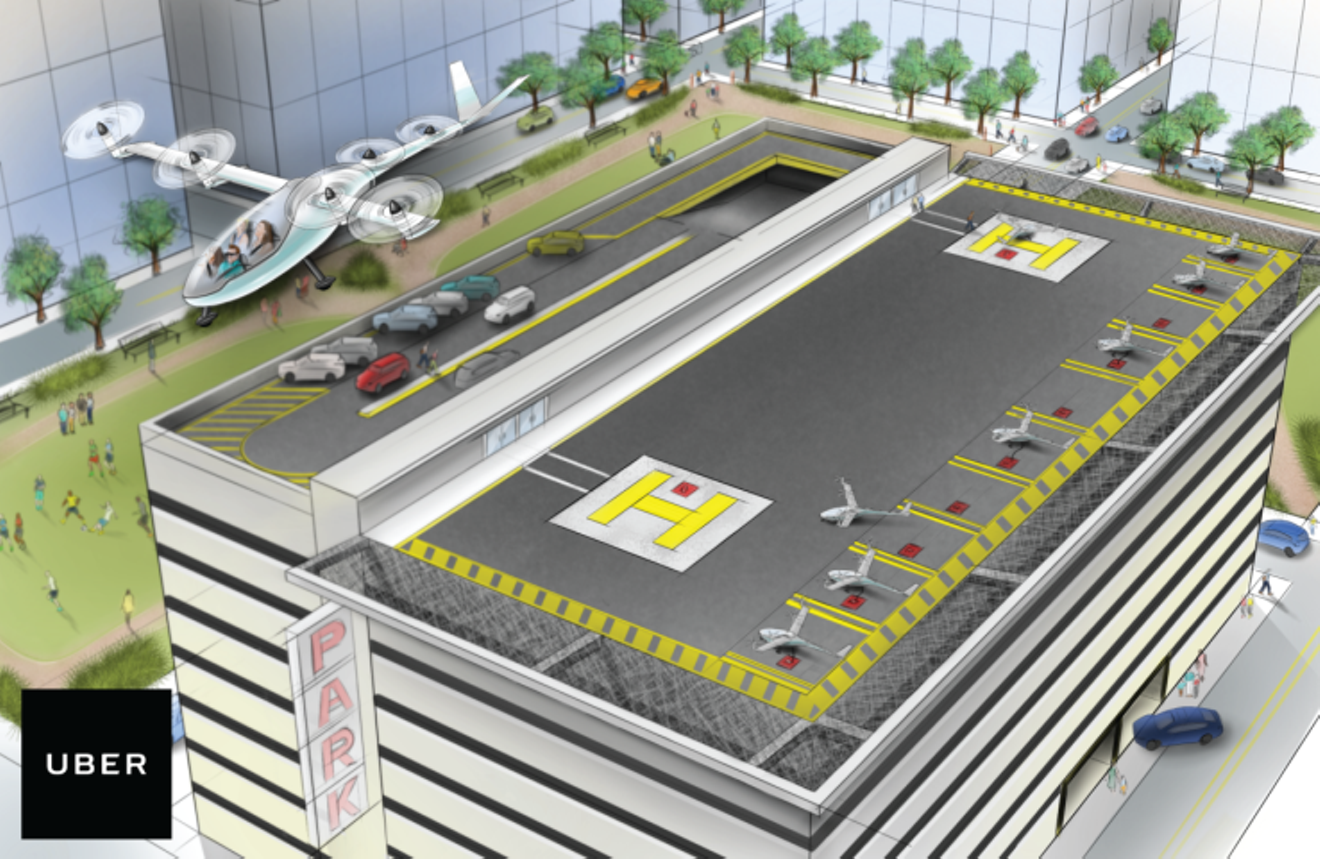Frisco Station will be the first spot to have a revenue route, which the company hopes opens in 2020. Uber expects "full-scale operations" to be launched on its network by 2023. "It's possible because we're radically reinventing the aircraft we're using," Holden says.
Well, maybe. Aerospace history is littered with ambitious ideas that flew headfirst into reality, from the Spruce Goose to Virgin Galactic. Here are four things that could ground this sci-fi concept before it even takes off.
1) Brand New Aircraft Blues
Company executives say that making an Uber Elevate network will require a new aircraft, an electric-powered vehicle that can zip through urban areas cleanly and quietly.
The good news is that this will be an airplane, not a flying car. This is engineering 101, George Jetson. Cars are optimized for roads and airplanes built for flying. Designing a vehicle that can operate in both modes means it will be a bad car and a terrible airplane. It’s painful but it’s true. You can’t argue with physics, engine design and aerodynamics.
The bad news is that these aircraft will be built from scratch. Sure, the design will depend on advancements that helicopter and aerial drone manufacturers are already working on: electric-powered vehicles, replacing tail rotors and adding more autonomous flight controls. These companies welcome anyone who may be a customer for these 21st century flying machines.
But the development of anything this new requires a perfect mix of engineering, business sense and regulatory finesse. New aircraft suffer delays, and the more novel the concept, the longer you can expect the delays will be to its deployment.
Here’s another secret: The FAA is pretty lenient when it comes to flying new aircraft if the only people at risk are pilots. When the health of paying customers and people on the ground are in play, however, this agency gets very uptight. A new flying taxi designed to operate in urban areas will get intense scrutiny, reviews and requests to redesign.
2) The FAA’s Protective Attitude Toward Airspace
While we’re on the topic of federal regulations, we might as well talk about airspace.
In 2012 Congress passed the Federal Aviation Administration Modernization and Reform Act so that private citizens could make money using small drones without getting a full pilot’s license. Congress gave the FAA more than three years to create the system. The agency took the entire time and introduced its Registration and Marking Requirements for Small Unmanned Aircraft in December 2015, and was so ham-handed that the FAA tweaked it in August 2016.
If it took four years for the FAA to get rules enabling 3-pound drones to fly 400 feet in the air, maximum. How long does Uber think it will take to open the airspace in DFW to a multitude of small aircraft, each zipping not from airport to airport, but from vertiports to people’s doors? This will require a whole new air traffic control scheme, with infrastructure and employees needed to track and deconflict flights. Automation and vehicle-to-vehicle communication technology is part of the answer, but these are new and the FAA will require reams of testing to be comfortable with it, and even then, it may take another congressional mandate to make happen.
As Uber moves through the regulatory process, expect local airlines to be heavily involved. Anything that changes a flight route of a commercial airplane costs them time and money on fuel. Anything that costs them money is an enemy. Any enemy must be attacked, via Congress. So there will be entrenched resistance from this powerful North Texas industry, which has deep hooks into the FAA. (As an example, see the way the airlines help shape the FAA approval for a spaceport in Waco, leading to restrictions on when rockets could launch.)
3) Landings Are Hard Without a Pad or Runway
The first phase of the Elevate plan, as described by Uber, features its aircraft staging from facilities near public transportation hubs and entertainment centers. You’d order a flight while leaving the Cowboys game, walk to the vertiport and zip home, laughing at the traffic jam below. Then the aircraft gets to your neighborhood and settles in for a landing.
Easier said than done. Take a look at where you live or work. You’re looking at trees, birds, structures and power lines, risks that can threaten any aircraft flying at low altitudes. Landing is worse, when a slope, stump or vehicle can cause a crash. Helicopters used for emergency medical flights are at risk of accidents, and they seek level 100-by-100-foot flat areas to land.
The aerospace industry has sought technology that mitigates these risks, with sensors and digital maps helping avoid catastrophes. Mediflights crashed a lot in 2008 but have gotten safer over time. So there’s hope. The problem arises when the concept is scaled up – instead of a discrete number of military pilots and first responders, we’re taking about a swarm paying customers and commercial pilots. And it will be harder to shrug off accidents, as happened with medical flights, if customers are hurt or killed.Uber Technologies Inc. is making money, but taking scary losses.
tweet this
4) Uber’s Money
Uber Technologies Inc. is making money, but taking scary losses. The company lost $991 million in the final quarter of 2016. The company generated $2.9 billion in revenue over that time, so the company’s massive global growth is absorbing the pain. Still, the losses have many worried, as do lawsuits over driverless car technology, and reports of sexual discrimination among the company's higher-ups are marring Uber's reputation.
There are two things the company needs to make Uber Elevate a fiscal reality. One is patience. The other is money. Given the upfront costs required to make a network of flying taxis, and the delays from engineering and regulatory circles, the 2020 launch date of Uber’s aircraft seems wildly optimistic.













